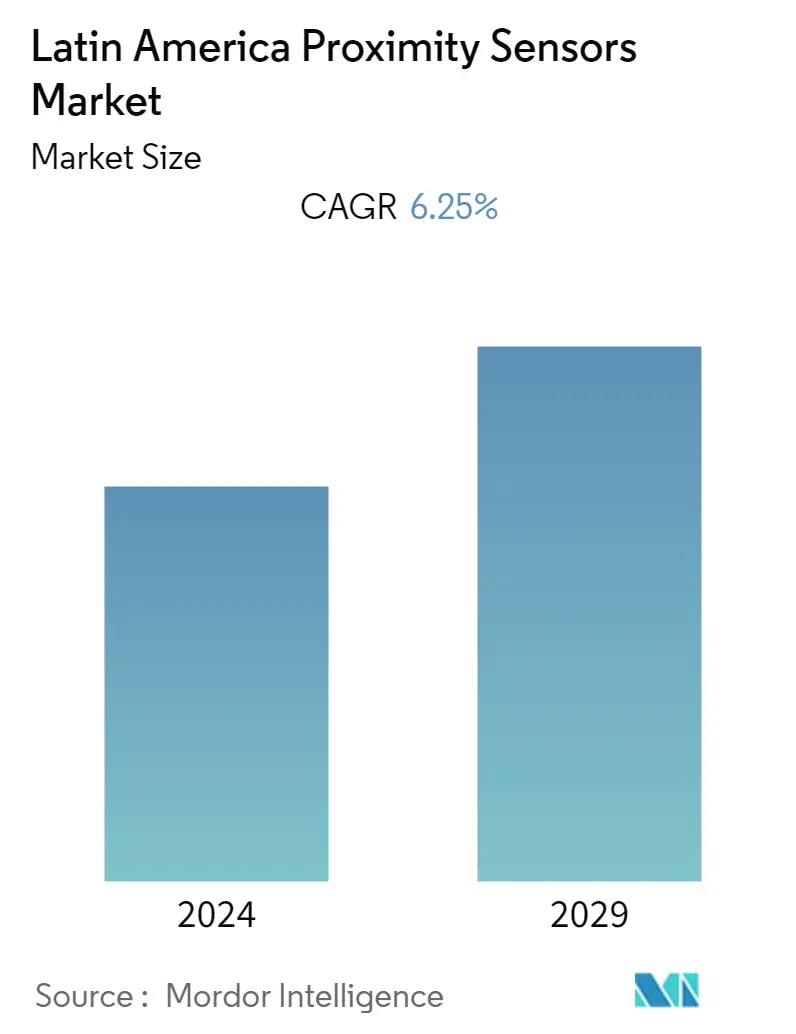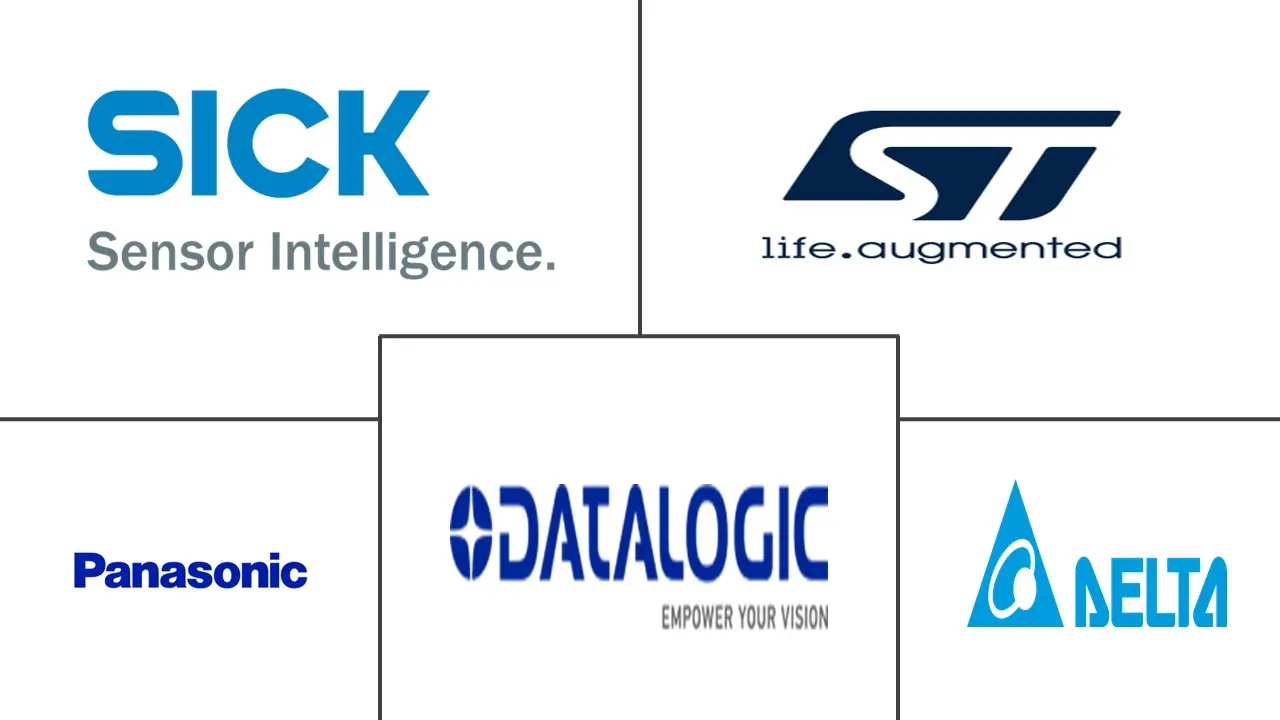Market Size of Latin America Proximity Sensors Industry

| Study Period | 2019 - 2029 |
| Base Year For Estimation | 2023 |
| Forecast Data Period | 2024 - 2029 |
| Historical Data Period | 2019 - 2022 |
| CAGR | 6.25 % |
| Market Concentration | Medium |
Major Players
*Disclaimer: Major Players sorted in no particular order |
Latin America Proximity Sensors Market Analysis
The Latin American Proximity Sensors Market is expected to reach a CAGR of 6.25% during the forecast period (2020 - 2025). Smartphone manufacturers are deploying proximity sensors in their product lines. This is directly impacting the demand. For instance, in October 2020, Huawei Y7a has been launched as the corporate's newest price range smartphone, a rebranded Huawei P Smart 2021. The new mannequin comes with a hole-punch show and gives quad rear cameras. Sensors onboard embrace an accelerometer, ambient gentle, magnetometer, and a proximity sensor. The cellphone additionally has a 4GB RAM + 64GB storage variant that is limited to the Latin American markets.
- Latin America is witnessing a digital transformation in both the public and private sectors to stay competitive in the global economic market. Mexico, Brazil, Panama, Argentina, Columbia, and Chile are among the leading countries in the region that are involved in adopting and promoting advanced solutions in their countries.
- In addition, improved efficiency and reduction in production costs, when compared to the conventional manufacturing process, is boosting the growth of industrial automation. At manufacturing sites, unforeseen facility stoppages are a major management issue directly linked to lost production opportunities. Thus, manufacturers are looking for ways to utilize smart devices and IoT to maintain and improve facility operation rates without relying on human experience or skills.
- Automation offers improved quality, standardization, and dependable products within the given time at a much lower cost. As proximity sensors play a major role in the monitoring and production of efficiency tasks, the market for proximity sensors is witnessing an expansion. For instance, SICK AG offers Inductive Proximity sensors, which is used in almost every area of factory and logistics automation. From cylindrical and rectangular standard sensors to special sensors for explosive zones and harsh environments, these sensors provide the intelligent, reliable route in implementing industry-specific and customized solutions to any automation scheme.
- The recent outbreak of COVID-19/Corona is influencing both the demand and production of the semiconductor industry. North America region hold a significant share in the semiconductor and electronics industry. The import and export has suuferred due to lack of production and us[pply chain disruptions. However, the demand for these sensors has increased due to the emphasis on the ability to automate monitoring of new safety policies, while empowering employees as part of the new normal in business operations. This has helped vendors to generate a new revenue stream and cope up to in terms of business continuity.
Latin America Proximity Sensors Industry Segmentation
A proximity sensor is a sensor that is able to detect the presence of nearby objects without any physical contact. For sensing objects, this sensor radiates or emits a beam of electromagnetic radiation, usually in the form of infrared light, and detects the reflection to determine the object's proximity or distance from the sensor. A proximity sensor often emits an electromagnetic field or a beam of electromagnetic radiation (for instance, infrared) and detects changes in the field or return signal. The study considers only B2B facet of proximity sensors usage and not B2C.
| Technology | |
| Inductive | |
| Capacitive | |
| Photoelectric | |
| Magnetic |
| End-User Vertical | |
| Aerospace and Defense | |
| Automotive | |
| Industrial | |
| Consumer Electronics | |
| Food and Beverage | |
| Other End-user Verticals |
| Country | |
| Mexico | |
| Brazil | |
| Argentina | |
| Rest of Latin America |
Latin America Proximity Sensors Market Size Summary
The Latin American Proximity Sensors Market is experiencing growth driven by the region's digital transformation and industrial automation efforts. Countries like Mexico, Brazil, and Argentina are at the forefront of adopting advanced technologies to enhance competitiveness in the global market. The demand for proximity sensors is being fueled by the need for improved efficiency and cost reduction in manufacturing processes. These sensors are integral to automation, offering benefits such as improved quality, standardization, and reliability in production. The automotive and consumer electronics sectors, in particular, are significant contributors to this demand, with Brazil's automotive industry leading the way in robotics and digital transformation initiatives. The presence of international players and investments in Industry 4.0 further bolster the market's expansion.
The market is moderately fragmented, with key manufacturers like Honeywell, OMRON, and Panasonic playing a significant role. The region's lower labor costs and the shift towards Industry 4.0 are facilitating the rapid expansion of various industrial sectors, including pharmaceuticals and consumer electronics. Proximity sensors, such as inductive and capacitive types, are widely used in industrial applications, contributing to the market's growth. The COVID-19 pandemic has also influenced the market, as businesses seek to automate monitoring and ensure safety in operations. As the construction industry grows, the demand for proximity sensors is expected to rise, supported by projects like Smart City Natal in Brazil, which integrates digital and environmental innovations.
Latin America Proximity Sensors Market Size - Table of Contents
-
1. MARKET DYNAMICS
-
1.1 Market Overview
-
1.2 Industry Attractiveness - Porter's Five Forces Analysis
-
1.2.1 Threat of New Entrants
-
1.2.2 Bargaining Power of Buyers
-
1.2.3 Bargaining Power of Suppliers
-
1.2.4 Threat of Substitutes
-
1.2.5 Intensity of Competitive Rivalry
-
-
1.3 Industry Value Chain Analysis
-
1.4 Impact of COVID-19 on the Industry
-
1.5 Market Drivers
-
1.5.1 Growth in Industrial Automation
-
-
1.6 Market Restraints
-
1.6.1 Limitations in Sensing Capabilities
-
-
-
2. MARKET SEGMENTATION
-
2.1 Technology
-
2.1.1 Inductive
-
2.1.2 Capacitive
-
2.1.3 Photoelectric
-
2.1.4 Magnetic
-
-
2.2 End-User Vertical
-
2.2.1 Aerospace and Defense
-
2.2.2 Automotive
-
2.2.3 Industrial
-
2.2.4 Consumer Electronics
-
2.2.5 Food and Beverage
-
2.2.6 Other End-user Verticals
-
-
2.3 Country
-
2.3.1 Mexico
-
2.3.2 Brazil
-
2.3.3 Argentina
-
2.3.4 Rest of Latin America
-
-
Latin America Proximity Sensors Market Size FAQs
What is the current Latin America Proximity Sensors Market size?
The Latin America Proximity Sensors Market is projected to register a CAGR of 6.25% during the forecast period (2024-2029)
Who are the key players in Latin America Proximity Sensors Market?
Panasonic Corporation, SICK AG, STMicroelectronics NV , Delta Electronics Inc. and Datalogic SpA are the major companies operating in the Latin America Proximity Sensors Market.

